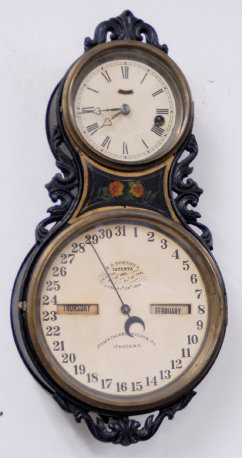
50. $700
“Brewster & Ingrahams, Bristol”, signed on the label in this
early steeple clock, ca 1844. It does not look as clean and shining as most clocks in this collection, but it is by far the most original.
First the negatives; the finial tips are broken, the 20-inch mahogany veneered case is almost black with 175 years of accumulated
dirtiness, and original painted zinc dial is dirty but has very little paint loss. Second the positives; It is all original, it is
running, the large 8-day brass springs are original-175 years old and still functioning, it has a complete label-that in itself is
a miracle, it has a rippled door-another unusual thing on an early clock, apparently original glasses. Now if you want a pretty clock,
pass on this one, if you want an original clock dating back to the early clockmaking days in the US, you should buy this one. $750-$1000.

51. $150
German steeple clock, in a nicely finished pine case with slant
bottom and latching door. It is 15 inches tall, all original and has no repairs or additions. There is no label, pendulum, nickel
bell, dial and hands are all original. The click is not holding the spring and I was too lazy to pull the dial and move it. The 30-hour
movement strikes a nickel bell. $150-$200.
49. $1500
Ithaca Calendar Clock Co. “Small Iron Case”, ca 1866. Some of the earliest clocks made by this company were installed in iron front cases cast by a local foundry. Henry B. Horton held the patent to both the calendar movements and the iron cases. The factory, with all their wood cases, was destroyed by fire, and while rebuilding they had these iron cases cast locally. This “small” iron case is 19” high and the “large” iron cases are 21” high. The case apparently has the original black paint. The dials, hands, bezels, and movements, are correct, but remember the paper dials are easy to get and easy to install and are usually changed every few years. The large calendar dial is signed all over by Ithaca and Horton. The painted metal cover between the two dials has good paint and appears also to be original. The movement is an 8-day, single spring, and Hubbell lever movement. Those movements were not signed but are original to the iron cases. There are no labels on the wood back and no evidence there ever were. The original wood back has seen better days. It needs some TLC and new screws to reattach to the back of the iron case. This model is the rarest of all the Ithaca iron cases and it is not pictured in Ly-Calendar. The iron cased Ithaca’s have always had high book values, around $4500 for the small and $3500 for the large. The last iron case we sold brought just under $5000. Ly-Calendar Clocks, pages 150-152. $2000-$3000.
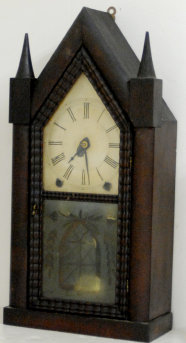
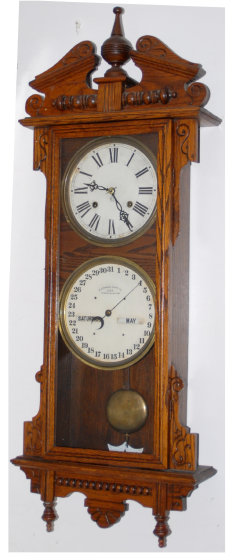
52. $1000
Waterbury Clock Company, hanging “Calendar No. 33”, ca 1908.
The oak case is 39” high and appears to be all original and in nice clean condition with exception of the bottom finials. It is a
difficult clock to hang with the two finials in place. Others have tried and broke the pegs on the finials so they have to be repeatedly
glued in place, then handled delicately. The finish is old, retaining some smoke and varnish, polished and rubbed recently so it does
give a good appearance. The glass is old, both dials are original and both are signed. It has the original pendulum bob, a signed
porcelain beat scale, and three correct hands. The 8-day movement is running, striking a Cathedral gong on half hours, and the calendar
is changing as intended. The calendar rolls the same color as the dials meaning dials and calendar rolls were replaced or the clock
has been pampered for a hundred years. There is most of a black label inside on the base and another on the back of the case. Ly-Waterbury
#277. This clock has had a high book value, over $2000 for several years. $1000-$1250.

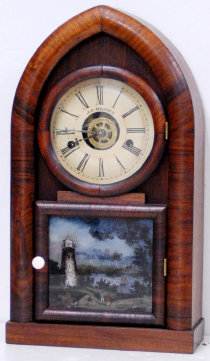
53. $300
“J. C. Brown, Forestville, Conn. U.S.A.”, copied from the
complete paper label inside this case, ca 1844. The beehive clock is only 13 inches high, very nice, covered with rosewood veneer
and very little wear and tear. No repairs to veneer showing. There are no wood problems and it has had no repairs. Both glasses are
very nice, the top glass is held with wood strips, the bottom has been in the door a long long time and may be original also, but
if original it definitely has been rebacked with black paint. The painted zinc dial has been repainted and shows his name above the
alarm ring. The hands and pendulum are period and correct for this model clock. A complete label is inside on the backboard. On the
door is Brown’s trademark porcelain door knob. The movement is one day and strikes on a coil gong. The clock also has an alarm movement
down in the base and it also rings on the coil gong. Reference: “Jonathan Clark Brown and the Forestville Manufacturing Company”,
by Kenneth D. Roberts and Snowden Taylor. $300-$500.

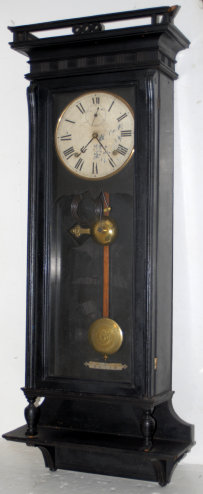
54. $1000
“Seth Thomas Clock Company. Thomaston, Conn.”, wall clock, “Suez”
model, ca 1883. In an ebonized case 44 inches high with unusual features on top and bottom. Apparently you could sit a flower pot
on top and empty your pockets at night and put them on a shelf on the bottom. The clock is original, no repairs evident, and just
shows 130 years of consistent use. The original dial has some paint flakes but so do all Seth Thomas dials this age. They made some
of the finest clocks but used crappy paint on their dials. It has an 8-day spring driven movement that is running and it strikes a
Cathedral gong on the hours. The dial ring, gong, and damascened pendulum ball are brass and the beat scale is nickel. Below the beat
scale is a complete black label from which the first line above was copied. The glass is possibly a replacement. I could not believe
when checked back thru tens of thousands of clock sales and say that I had only sold one Suez in 45 years. Ly-Seth Thomas, page 328.
$1000-$1500.